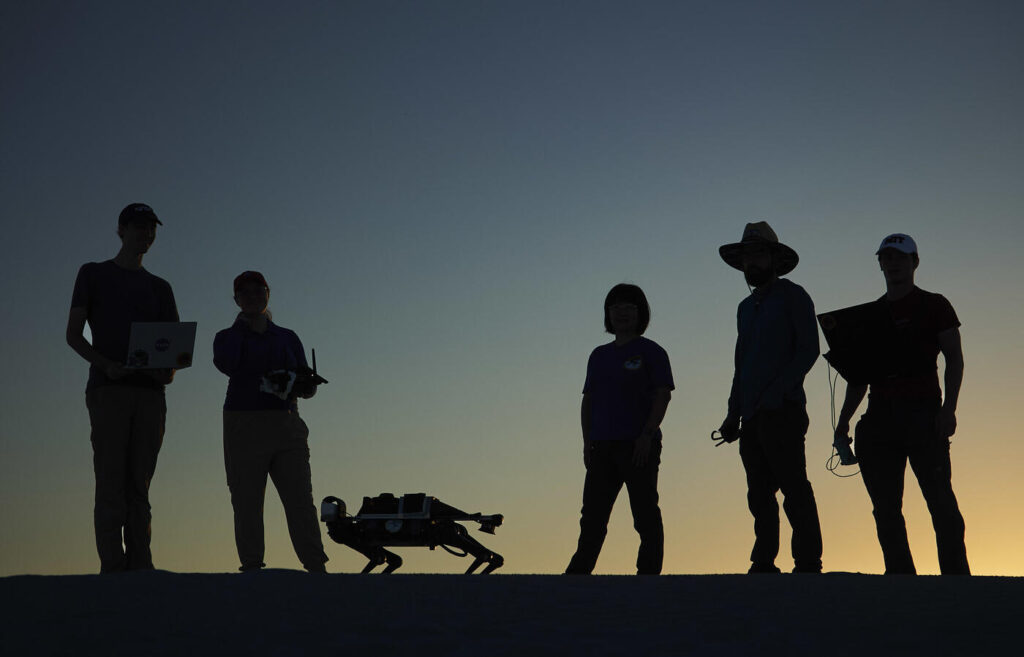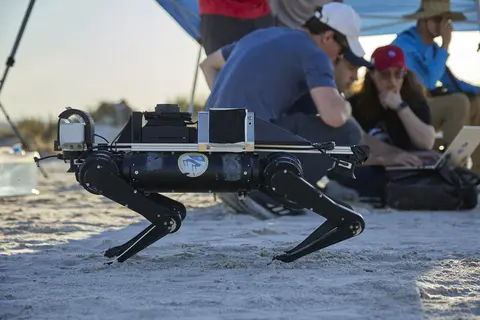Researchers are teaching robots to walk on Mars from the sand of New Mexico
 Scientists and robot at White Sands National Park.
Scientists and robot at White Sands National Park.
By Sean Nealon
Researchers are closer to equipping a dog-like robot to conduct science on the surface of Mars after five days of experiments this month at White Sands National Park in New Mexico.
The national park is serving as a Mars analog environment and the scientists are conducting field test scenarios to inform future Mars operations with astronauts, dog-like robots known as quadruped robots, rovers and scientists at Mission Control on Earth. The work builds on similar experiments by the team with the same robot on the slopes of Mount Hood in Oregon, which simulated the landscape on the Moon.
“Our group is very committed to putting quadrupeds on the Moon and on Mars,” said Cristina Wilson, a robotics researcher in the College of Engineering at Oregon State University. “It’s the next frontier and takes advantage of the unique capabilities of legged robots.”
The NASA-funded project supports the agency’s Moon to Mars program, which is developing the tools for long-term lunar exploration and future crewed missions to Mars. It builds on research that has enabled NASA to send rovers and a helicopter to Mars.
The LASSIE Project: Legged Autonomous Surface Science in Analog Environments includes engineers, cognitive scientists, geoscientists and planetary scientists from Oregon State, the University of Southern California, Texas A&M University, the Georgia Institute of Technology, the University of Pennsylvania, Temple University and NASA Johnson Space Center.
The field work this month at White Sands was the second time the research team visited the national park. They made the initial trip in 2023 and also made trips in 2023 and 2024 to Mount Hood. During these field sessions, the scientists gather data from the feet of the quadruped robots, which can measure mechanical responses to foot-surface interactions.
“In the same way that the human foot standing on ground can sense the stability of the surface as things shift, legged robots are capable of potentially feeling the exact same thing,” Wilson said. “So each step the robot takes provides us information that will help its future performance in places like the Moon or Mars.”
 Quadruped robot.
Quadruped robot.
The conditions at White Sands this month were challenging. Triple-digit high temperatures meant the team started field work at sunrise and wrapped by late morning because of the rising heat index and its impact on the researchers and the power supply to the robots.
But the team made important progress. Improvements to the algorithms they have refined in recent years led for the first time to the robot acting autonomously and making its own decisions.
This is important, Wilson noted, because in a scenario where the quadruped would be on the surface of Mars with an astronaut, it would allow both the robot and the astronaut to act independently, increasing the amount of scientific work that could be accomplished.
They also tested advances they have made in developing different ways for the robot to move depending on surface conditions, which could lead to increased energy efficiency, Wilson said.
“There is certainly a lot more research to do, but these are important steps in realizing the goal of sending quadrupeds to the Moon and Mars,” Wilson said.
Other leaders of the project include Feifei Qian, USC; Ryan Ewing and Kenton Fisher, NASA Johnson Space Center; Marion Nachon, Texas A&M; Frances Rivera-Hernández, Georgia Tech; Douglas Jerolmack and Daniel Koditschek, University of Pennsylvania; and Thomas Shipley, Temple University.
The research is funded by the NASA Planetary Science and Technology through Analog Research (PSTAR) program, and Mars Exploration Program.
Snap-through effect helps engineers solve soft material motion trade-off
Humanoid robots showcase skills at Ancient Olympia. But they’re on a long road to catch up to AI
Grammarly Gets Serious Chops As Writing Tool
Best known as a proofreading and editing solution, Grammarly has repositioned itself as a full-fledged AI writer.
Essentially, the tool has been significantly expanded with a new document editor designed to nurture an idea into a full-blown article, blog post, report and similar – with the help of a number of AI agents.
Dubbed Grammarly ‘Docs,’ the AI writer promises to amplify your idea every step of the way – without stepping on your unique voice.
In other news and analysis on AI writing:
*Now You can Auto-Write Your Gmails Inside ChatGPT: AI expert Matt Paiva has figured-out a way to use ChatGPT to auto-write emails for Gmail – without ever leaving the ChatGPT interface.
An incredible time-saver, Paiva’s method is detailed step-by-step in this YouTube video, which capitalizes on ChatGPT’s new ability to make direct connections with a number of outside apps now.
One caveat: If you’re a novice, you may want to play this fast-paced tutorial a few times to get what’s going on – but even so, the juice is worth the squeeze.
*AI Agent-Driven Email Arrives: 6sense has released a new email marketing suite that uses AI agents to drive the email marketing process.
The idea: Use AI agents to write all the marketing emails, send and follow-up, read/analyze replies, respond accordingly – and then route hot leads to sales reps as soon as those manifest.
While such automation has been around for a while, it will be interesting to see if 6sense’s decision to ‘agentify’ the process brings significant new gains.
*Discount Version of ChatGPT Released in India: Fans of ChatGPT in India now have a tier level they can call their own – dubbed ChatGPT Go – that costs less than $US5 / month.
Essentially, subscribers get 10 times more message and image generating capability with Go as compared to ChatGPT Free.
ChatGPT’s maker is experimenting with the discount version in India only, with an eye towards offering the new tier in other countries if it makes sense.
*AI Writing Comes to WhatsApp: Users of the wildly popular WhatsApp now have a new AI writer.
Dubbed ‘Writing Help,’ the new tool is designed to help users draft error-free messages so they can respond even more quickly to family, friends and colleagues.
Writing Help also offers users the ability to send messages in various styles, including professional, funny or supportive.
*Top Ten AI Reworders: Technically, AI chatbots/writers like ChatGPT already have the ability to reword your text in all sorts of ways.
You simply need to describe the kind of writing you’re looking for (such witty, button-downed, ‘out there,’ etc.) ask ChatGPT to rewrite in that style and you’re done.
Even so, there are tools specially designed to reword your text — and writer Alicia Keller offers an excellent rundown on what’s available.
*Google’s Upgraded AI Image Generator Turning Heads: Google is out with a new version of its image generator with an exceedingly powerful new feature: The ability to faithfully replicate a person’s face/body, no matter how many times you edit that image.
The capability is perfect for someone who is trying to touch-up their headshot, for example, and wants to experiment with all sorts of effects while ensuring that their image an exact replica of who they are.
Until now, AI image generators were never able to stay true to the image of a person and instead churned-out images that only “sorta, kinda” looked like the person in the original image the generator was working with.
*Time Magazine Releases Its Top 100 People in AI: Time has released its own take on the top movers and shakers in AI, dubbed “TIME100 AI.”
Many of the names AI insiders would expect are on there.
But there are a few surprises, including Pope Leo XIV.
*ChatGPT Voice Tech Gets a Polish: Users who prefer interacting with AI via voice should ultimately be more pleased with that mode in months to come.
The reason: ChatGPT’s maker has introduced an upgrade to the underlying technology and released it to software developers.
In a perfect world, that will mean more AI apps coming down the pipeline that work with voice even better than they do now.
*AI BIG PICTURE: Stanford University Study: AI Making It Tougher for Young People to Find Jobs: Turns-out all those dire warnings about AI vacuuming up jobs are becoming reality.
A new study from Stanford finds AI is taking entry level jobs from young people, 22-25 – especially those looking to work in software engineering or customer service.
Observes writer Nick Lichtenberg: “The analysis revealed a 13% relative decline in employment for early-career workers in the most AI-exposed jobs since the widespread adoption of generative-AI tools.”

Share a Link: Please consider sharing a link to https://RobotWritersAI.com from your blog, social media post, publication or emails. More links leading to RobotWritersAI.com helps everyone interested in AI-generated writing.
–Joe Dysart is editor of RobotWritersAI.com and a tech journalist with 20+ years experience. His work has appeared in 150+ publications, including The New York Times and the Financial Times of London.
The post Grammarly Gets Serious Chops As Writing Tool appeared first on Robot Writers AI.

